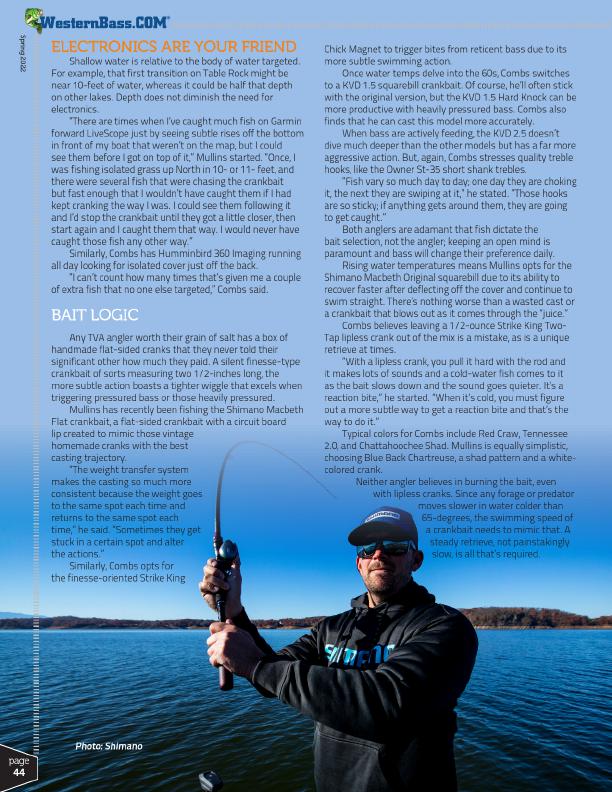
Spring 2022
®
ELECTRONICS ARE YOUR FRIEND
Shallow water is relative to the body of water targeted. For example, that first transition on Table Rock might be near 10-feet of water, whereas it could be half that depth on other lakes. Depth does not diminish the need for electronics.
“There are times when I’ve caught much fish on Garmin forward LiveScope just by seeing subtle rises off the bottom in front of my boat that weren’t on the map, but I could see them before I got on top of it,” Mullins started. “Once, I was fishing isolated grass up North in 10- or 11- feet, and there were several fish that were chasing the crankbait but fast enough that I wouldn’t have caught them if I had kept cranking the way I was. I could see them following it and I’d stop the crankbait until they got a little closer, then start again and I caught them that way. I would never have caught those fish any other way.”
Similarly, Combs has Humminbird 360 Imaging running all day looking for isolated cover just off the back.
“I can’t count how many times that’s given me a couple of extra fish that no one else targeted,” Combs said.
BAIT LOGIC
Any TVA angler worth their grain of salt has a box of handmade flat-sided cranks that they never told their significant other how much they paid. A silent finesse-type crankbait of sorts measuring two 1/2-inches long, the more subtle action boasts a tighter wiggle that excels when triggering pressured bass or those heavily pressured.
Mullins has recently been fishing the Shimano Macbeth Flat crankbait, a flat-sided crankbait with a circuit board lip created to mimic those vintage homemade cranks with the best casting trajectory.
“The weight transfer system makes the casting so much more consistent because the weight goes to the same spot each time and returns to the same spot each time,” he said. “Sometimes they get stuck in a certain spot and alter the actions.”
Similarly, Combs opts for the finesse-oriented Strike King
Chick Magnet to trigger bites from reticent bass due to its more subtle swimming action.
Once water temps delve into the 60s, Combs switches to a KVD 1.5 squarebill crankbait. Of course, he’ll often stick with the original version, but the KVD 1.5 Hard Knock can be more productive with heavily pressured bass. Combs also finds that he can cast this model more accurately.
When bass are actively feeding, the KVD 2.5 doesn’t dive much deeper than the other models but has a far more aggressive action. But, again, Combs stresses quality treble hooks, like the Owner St-35 short shank trebles.
“Fish vary so much day to day; one day they are choking it, the next they are swiping at it,” he stated. “Those hooks are so sticky; if anything gets around them, they are going to get caught.”
Both anglers are adamant that fish dictate the bait selection, not the angler; keeping an open mind is paramount and bass will change their preference daily.
Rising water temperatures means Mullins opts for the Shimano Macbeth Original squarebill due to its ability to recover faster after deflecting off the cover and continue to swim straight. There’s nothing worse than a wasted cast or a crankbait that blows out as it comes through the “juice.”
Combs believes leaving a 1/2-ounce Strike King Two- Tap lipless crank out of the mix is a mistake, as is a unique retrieve at times.
“With a lipless crank, you pull it hard with the rod and it makes lots of sounds and a cold-water fish comes to it as the bait slows down and the sound goes quieter. It’s a reaction bite,” he started. “When it’s cold, you must figure out a more subtle way to get a reaction bite and that’s the way to do it.”
Typical colors for Combs include Red Craw, Tennessee 2.0, and Chattahoochee Shad. Mullins is equally simplistic, choosing Blue Back Chartreuse, a shad pattern and a white- colored crank.
Neither angler believes in burning the bait, even
with lipless cranks. Since any forage or predator
moves slower in water colder than
65-degrees, the swimming speed of
a crankbait needs to mimic that. A
steady retrieve, not painstakingly
slow, is all that’s required.
page 44
Photo: Shimano